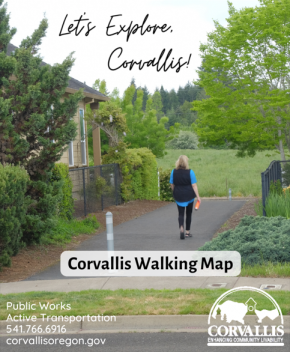Active Travel Corridors
A Network for People
Active Travel Corridors (ATCs) are a transportation network that has been part of the Corvallis community for years, but only recently has it been mapped out. ATCs are neighborhood shortcuts for people walking, rolling and biking. They are comfortable, “people only” paths that connect streets to parks, schools and other streets, shortening trips for people traveling by active travel modes.
Where are ATCs?
ATCs have been quietly developing on Corvallis streets for decades. The chances are good that you may even know of some within your own neighborhood! They are mostly found on streets that offer no exit for motorized vehicles ("Dead End" or “No Outlet” streets), yet a usable network does continue for people traveling by foot, wheel or mobility device. These little connections provide a shorter way through and between neighborhoods than following sidewalks along streets.
Mapping the Corvallis ATC Network
Below is our interactive map with locations discovered by the Corvallis community.
Download or Pick Up You Corvallis Walking/ATC Map
To showcase the community-created Active Travel Corridor network, we have produced the Corvallis Walking/ATC Map—a handy, pocket-sized guide for navigating Corvallis by foot.
Pick up your free, waterproof Walking/ATC Map at any one of these six locations:
- City Hall
- Corvallis-Benton County Public Library
- Osborn Aquatic Center
- Corvallis Cyclery
- First Alternative Natural Foods Co-op North Store
- First Alternative Natural Foods Co-op South Store
Download the Digital Version Here!

ATC Signage
To further highlight the network, the Active Transportation Team has added messaging to dead end signs where ATCs provided a way through for people walking, biking, and/or rolling. Most of these signs indicate that all users can get through, though we’ve developed specialized signs to indicate an ATC with a stairway or an ATC that we recommend only pedestrians use.
What does an ATC Look Like?
Below is an example of two Dead End streets (NW 7th St. and NW 8th St.). Both streets stop vehicular travel to Linn-Benton Community College but both streets also have corridors at the end of the street which allow continuous access for people to connect to the college through walking or riding. These particular corridors happen to have a 5’ wide concrete walkway, but ATCs may vary in width and/or be made of other materials, such as wood chips, gravel, etc.
Different Types of ATCs
There are a number of different types of ATCs within Corvallis. What they all have in common is that they do the same thing—connect neighborhoods and provide living ends instead of dead ends.
End-of-cul-de-sac ATC
The end-of-cul-de-sac ATC is the classic example of an ATC, beginning and/or ending where a vehicle may not continue. Many times, the corridor is a small section of public right of way that allows travel between two houses. This ATC connects a cul-de-sac to a major road.
Mid-block ATC
Another common ATC is one that enters/exits into the mid-block of a road. Unless the user is familiar with the area, and without an intersection nearby to define location, coming out mid-block can produce slightly disorienting experience until landmarks or signs are available to help provide guidance. This ATC connects a cul-de-sac to a through street.
Bridge Connected ATC
ATCs can also connect to structures and trails such as bridges, staircases and shared-use paths. This ATC connects two cul-de-sac’s with a small footbridge.
Help Us Craft the Future of Corvallis ATCs
Do you have a location that isn’t shown on our map that should be? Do you have other ideas on how the ATC network could improve? Contact us! We welcome your input.
Subscribe to the Active Transportation Newsletter here to stay up to date as the network continues to develop.